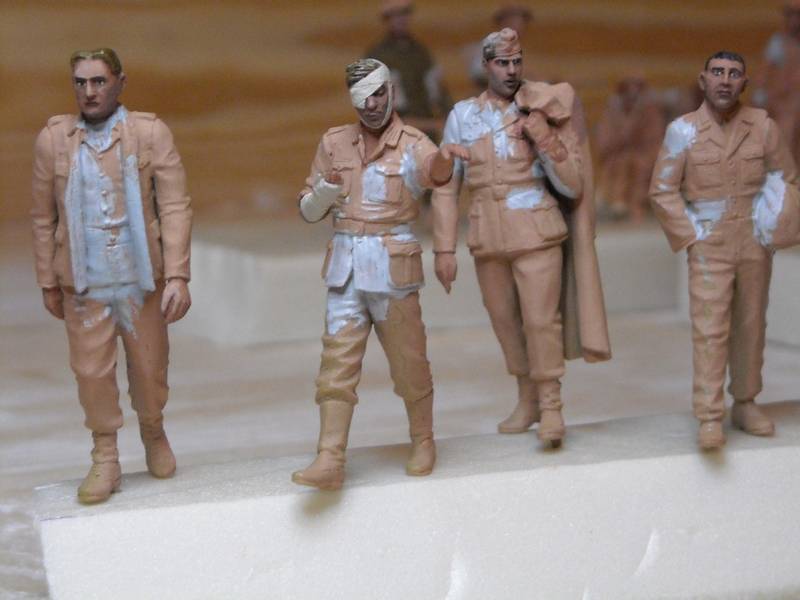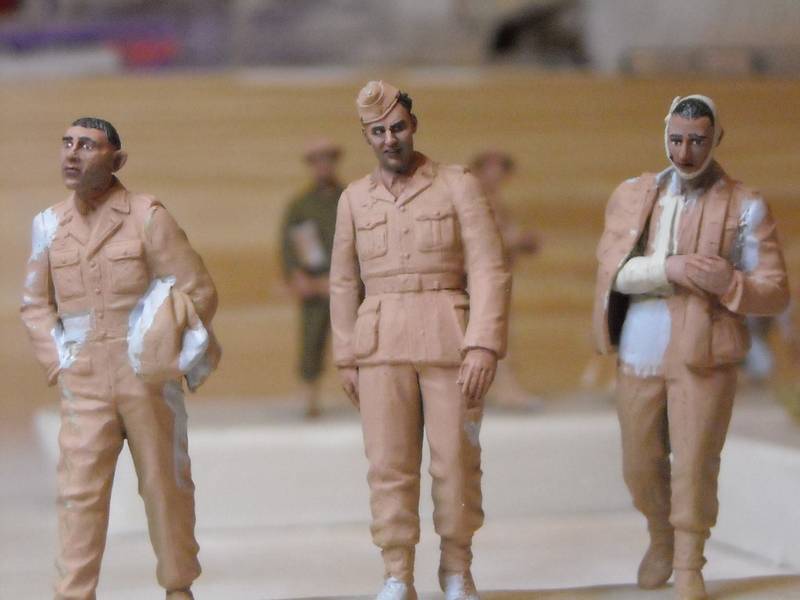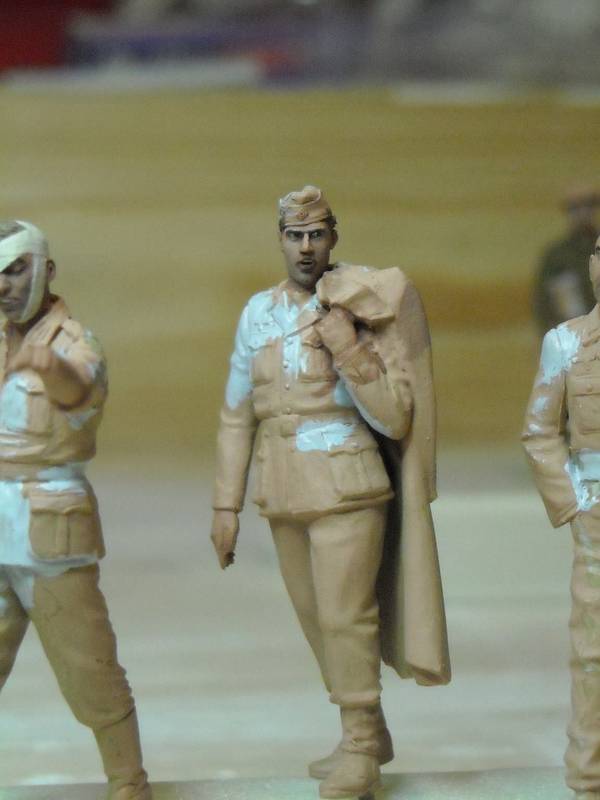Picture the scene: D-Day plus about a week, British troops are moving steadily inland from the Normandy landings, overcoming German positions one after another as they meet them in the French countryside... A pair of Universal Carriers and a squad of infantry have just taken out a 20mm flak gun at a bend in the road, with little bloodshed but a clutch of prisoners taken. For the first time, Churchill's 1942 speech about the "end of the begining" starts to ring true with the brave tommies, and they are spurred to further victories in the closing year of the war.
List of kits to use:
Masterbox's German Captives; British troops, Caen; Road to the Rear...
Two of Tamiya's Universal Carriers; British Infantry on Patrol
Resicast's Stowage and tracks for Universal Carrier,
Hornet/Wolf British/Commonwealth soldiers, replacement headsets,
Tristar 20mm Flak38 Sd.Ah.51, with replacement barrel,
Dragon British Infantry Normandy 1944
I'm just cutting contours for a road and ditch, with a junction and bridge, out of foamboard, which I'll coat in plaster bandage, adding details with Das air drying clay. If I had a scanner, I'd draw you a picture to illustrate.
It's my first foray back into modelling for about nine months, a gentle start, with plenty of groundwork, some figures and a couple of small vehicles...
I promise to take photos when it's more underway!
Thanks for looking in!
Richard
Hosted by Darren Baker
...End of the Beginning
Posted: Thursday, October 15, 2009 - 10:33 PM UTC
Posted: Tuesday, October 20, 2009 - 05:42 AM UTC
Does anybody know if the geology of Normandy would permit the construction of half-brick/half-flint walls like these?
brick and flint
They are very common in south-eastern England. I want one to run alongside the road in the dio, as if it's the boundary wall of a large estate, and a half brick/flint one would be visually be more interesting than a plain brick one...
Any help or information gratefully received
Richard
brick and flint
They are very common in south-eastern England. I want one to run alongside the road in the dio, as if it's the boundary wall of a large estate, and a half brick/flint one would be visually be more interesting than a plain brick one...
Any help or information gratefully received
Richard
trackpads

Joined: December 17, 2008
KitMaker: 330 posts
Armorama: 284 posts

Posted: Tuesday, October 20, 2009 - 05:56 AM UTC
hello mate nice idea,i have seen a few pics of a firefly parked along side a wall that looks a like the one on the top left corner it had ivory hanging of it.and the grass was nice and tall about waste hight. i'll see if i can get it scanned in and post it for you.
trackpads
trackpads
Posted: Tuesday, October 20, 2009 - 09:18 PM UTC
Many thanks Andrew, would appreciate that...
Posted: Wednesday, December 02, 2009 - 09:35 AM UTC
Ok, here are the first photos (if I remember how to link to them correctly)
I wanted to include a shot of the base layout, but because it's made of DAS clay, it just looks like a bleached out snowscene. So, here are the six German POW's, well, their faces... uniforms to come...



Hopefully I'll have some more soon, I only have about three hours a week to do the models...
The two universal carriers are undercoated, and have the first details on, more to do, including the delicate Resicast tracks, which are filling me with trepidation at the thought of putting them together, anybody who's dealt with them care to reassure me?
Feedback welcome
I wanted to include a shot of the base layout, but because it's made of DAS clay, it just looks like a bleached out snowscene. So, here are the six German POW's, well, their faces... uniforms to come...



Hopefully I'll have some more soon, I only have about three hours a week to do the models...
The two universal carriers are undercoated, and have the first details on, more to do, including the delicate Resicast tracks, which are filling me with trepidation at the thought of putting them together, anybody who's dealt with them care to reassure me?
Feedback welcome
roudeleiw

Joined: January 19, 2004
KitMaker: 2,406 posts
Armorama: 2,224 posts

Posted: Wednesday, December 02, 2009 - 07:26 PM UTC
Quoted Text
Does anybody know if the geology of Normandy would permit the construction of half-brick/half-flint walls like these?
brick and flint
Richard
Richard,
I would say that this is definetly ok.
The flint (called "galets" in France) is basically washed out of the chalk cliffs and there is a whole industry around the "Baie de la Somme" on the french side ( i spend a week there in September).
A lot of houses (at least in that area ) are exactly as shown on your link.
Here is a french site with similar pictures
Galets
As i was there i , typically for a modeler, imagined how i would build that, so i am really interested to see how you are going to do!
Have fun
Claude

Sean50

Joined: March 20, 2007
KitMaker: 340 posts
Armorama: 328 posts

Posted: Wednesday, December 02, 2009 - 10:17 PM UTC
Hello there,
Sorry to disagree, but I don't think flint construction is at all common on Normandy, certainly not in Lower Normandy (ie the area appropriate to the diorama).
The use of red bricks is also reasonably uncommon, seems to be more decorative than functional. Most buildings, walls or whatever were/are from the local stone, be it granite (common in la Manche, or what you might call the US sector), or limestone further east, which I think would be right for this scene.
Check out Pat Elie's (I think they're his) pictures in the "Normandy then and now" post below.
Hope this helps,
Sean
Sorry to disagree, but I don't think flint construction is at all common on Normandy, certainly not in Lower Normandy (ie the area appropriate to the diorama).
The use of red bricks is also reasonably uncommon, seems to be more decorative than functional. Most buildings, walls or whatever were/are from the local stone, be it granite (common in la Manche, or what you might call the US sector), or limestone further east, which I think would be right for this scene.
Check out Pat Elie's (I think they're his) pictures in the "Normandy then and now" post below.
Hope this helps,
Sean
Posted: Wednesday, December 02, 2009 - 10:27 PM UTC
Thanks guys for your replies, both help, even though they are conflicting...
I think I'm going to include a flint/galet wall, because, although not common, the wall being depicted is a boundary wall for a country house or stately home, so it would be unusual or specially built. I think a plain wall would be a bit dull, and I want to add that little bit of contrast to the normally seen hedgerows...
I'm planning to scribe the bricks into foamex, carve the half-round top and pillars from dense builder's foam, and use railroad scale plastic cobble sheets for the galets, shaving the tops of random ones to show where they've been cracked. I grew up in north Essex, where there is loads of chalk and flint, so I'm well used to the variety of colours and textures. Also whilst digging in the garden as a child, am well used to the deep and painful cuts from the broken bits of flint buried there!
I think I'm going to include a flint/galet wall, because, although not common, the wall being depicted is a boundary wall for a country house or stately home, so it would be unusual or specially built. I think a plain wall would be a bit dull, and I want to add that little bit of contrast to the normally seen hedgerows...
I'm planning to scribe the bricks into foamex, carve the half-round top and pillars from dense builder's foam, and use railroad scale plastic cobble sheets for the galets, shaving the tops of random ones to show where they've been cracked. I grew up in north Essex, where there is loads of chalk and flint, so I'm well used to the variety of colours and textures. Also whilst digging in the garden as a child, am well used to the deep and painful cuts from the broken bits of flint buried there!
roudeleiw

Joined: January 19, 2004
KitMaker: 2,406 posts
Armorama: 2,224 posts

Posted: Wednesday, December 02, 2009 - 10:30 PM UTC
Quoted Text
Hello there,
Sorry to disagree, but I don't think flint construction is at all common on Normandy, certainly not in Lower Normandy (ie the area appropriate to the diorama).
The use of red bricks is also reasonably uncommon, seems to be more decorative than functional. Most buildings, walls or whatever were/are from the local stone, be it granite (common in la Manche, or what you might call the US sector), or limestone further east, which I think would be right for this scene.
Check out Pat Elie's (I think they're his) pictures in the "Normandy then and now" post below.
Hope this helps,
Sean
Sean, that's why i sayed "at least in this area".
I did not want to make the specific research for the area of the dio. But i have a few pictures from St-Valéry sur Somme with such a mix of bricks and galets.
Cheers
Claude
slodder

Joined: February 22, 2002
KitMaker: 11,718 posts
Armorama: 7,138 posts

Posted: Wednesday, December 02, 2009 - 11:01 PM UTC
The faces are mostly good. The eyes on the guys on the outside of the 1st 2 photographs are a big 'wide eyed' The guy with the bandage around his head has puples that look to be too large, comic like almost. If you can shrink them he'd be much better. The others have puples that are too round. If you can add a touch of white to the lower puple it would look better.
The facial tones and rough beards are great.
The facial tones and rough beards are great.
 |










